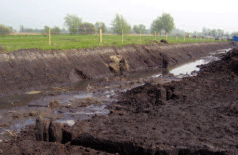Archaeologists to revisit Beccles marshes this summer
Archaeologists from the University of Birmingham and Suffolk County Council, will return to a 2,000-year-old site on Beccles marshes this summer, and will be undertaking the excavation from late July 2009.
Three long rows of wooden posts inserted into the ground were unearthed while flood defence work was being carried out on the marshes in 2006.
Initial thoughts were that the posts were to mark a causeway, but the real purpose of the site remains a mystery, it could be that of a ritual gathering point, similar to the one discovered at nearby Barsham.
Experts have used tree rings to date the wood to the spring of 75 BC.
There will be an open day on the site, giving the public the chance to learn more about this part of the history of the Waveney Valley.
Please see article below from the original 2006 excavation:
Contractors working on the Environment Agency’s multi million pound flood alleviation strategy on Beccles Town marshes discovered a number of vertical timber remains which had clearly been sculpted by hand.
 Realizing these were more than old timber fence posts staff from SCC Archaeological Field Services Team were contacted and subsequently identified a number of preserved timbers relating to a wooden structure, possibly an ancient causeway.
Realizing these were more than old timber fence posts staff from SCC Archaeological Field Services Team were contacted and subsequently identified a number of preserved timbers relating to a wooden structure, possibly an ancient causeway.
Some Roman pottery remains were also recovered and samples of the timbers were removed for dating. The initial results showed that all of the timbers sampled represented a different stage of the site, with phases dating from the Bronze Age, Iron Age and the Roman period.
 The Institute of Archaeology and Antiquity’s Henry Chapman, Ben Geary and Andy Howard were called in on the investigation due to their expertise in wetland archaeology deposits. The results have so far been excellent and suggest that a wooden causeway more than half a mile long may have run from dry land on the edge of Beccles, across a swamp to a spot on the River Waveney.
The Institute of Archaeology and Antiquity’s Henry Chapman, Ben Geary and Andy Howard were called in on the investigation due to their expertise in wetland archaeology deposits. The results have so far been excellent and suggest that a wooden causeway more than half a mile long may have run from dry land on the edge of Beccles, across a swamp to a spot on the River Waveney.
 A 30m long section of the causeway has been recorded with over forty in-situ timber posts uncovered to date. The posts are surrounded by woodworking debris and horizontal timbers, which possibly once represented a platform around the posts. At 5m wide, it was capable of carrying carts and was the Bronze Age equivalent of a motorway. Archaeologists have been stunned to find that it was in use from the Bronze Age in around 1000BC, through the Iron Age, to Roman times and at least the 4th century AD.
A 30m long section of the causeway has been recorded with over forty in-situ timber posts uncovered to date. The posts are surrounded by woodworking debris and horizontal timbers, which possibly once represented a platform around the posts. At 5m wide, it was capable of carrying carts and was the Bronze Age equivalent of a motorway. Archaeologists have been stunned to find that it was in use from the Bronze Age in around 1000BC, through the Iron Age, to Roman times and at least the 4th century AD.
Dr Henry Chapman said: ‘You can put this on a par with any of the big monuments in terms of effort to construct it. Decking is the best way I can describe it. You have got a causeway which has been used for a tremendous amount of time, which is unique; we haven’t got something like that. It has been added to over time to preserve it, which shows its importance to early Beccles. A desire to cross a wetland which is changing in its character throughout that time is just bizarre.’
Mr Paul Mitchelmore of the Environment Agency said: ‘It would be fantastic if some of the artefacts could be put on display in the Beccles Museum to give local people a view of what is on their doorstep.’









